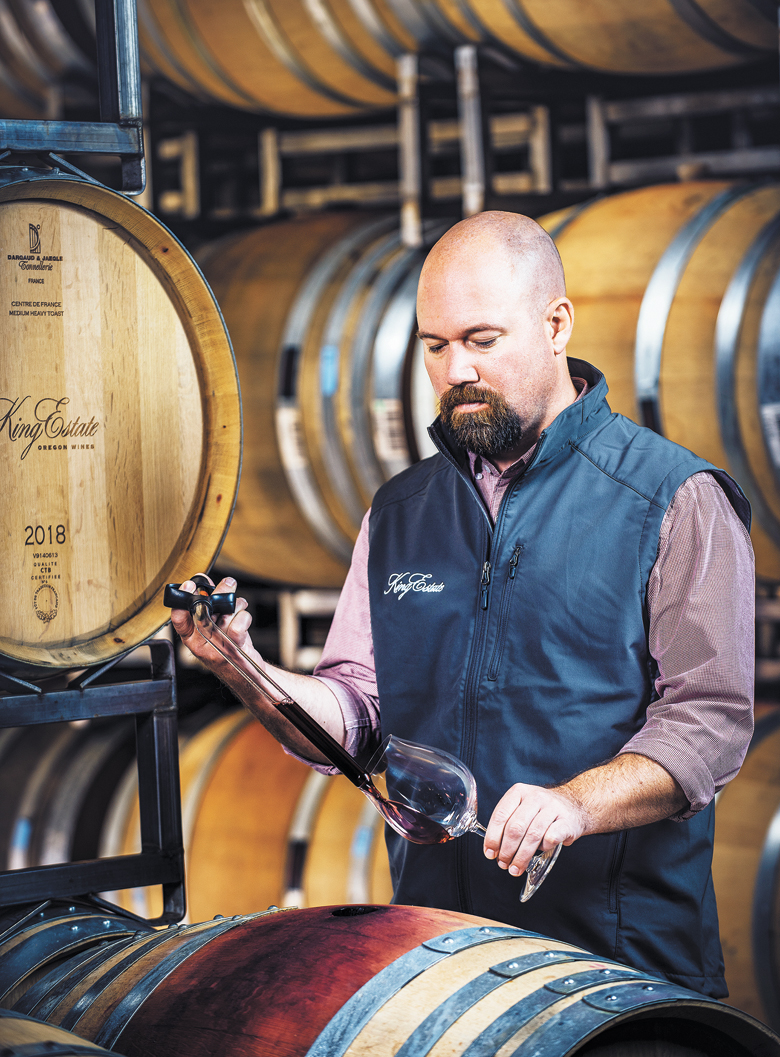No Lot Too Small
Boutique treasures inside King Estate
By Paul Omundson
The boutique winery typically consists of a two- or three-person family enterprise in which hands-on means meticulously tended fruit in vineyards next to home and winery, with focused attention from harvest through bottling in batches of 500 or fewer cases. This artisan approach amplifies wines’ ability to reflect a distinct sense of place in flavor and character.
Now you can find such jewels at one of the state’s largest producers, King Estate. Of course, at first glance, you wouldn’t think such a paradox possible. The estate’s 1,033 acres sprawl over the foothills of the Lorane Valley in the extreme southwest corner of the Willamette Valley AVA. About one-third of total production, 327,000 cases, comes from the site’s 470 organic acres of vines; the other half is sourced from vineyards throughout Oregon and Washington.
Since the winery started in 1991, owner Ed King has focused on both big and small lots. These boutique offerings are crafted primarily to delight wine club members, but visitors to the tasting room and restaurant are most welcome to tap into this treasure as well.

Winemaker’s delight
Although King Estate represents a large operation, small tanks can be found all around the winery. Tending to the numerous smaller vessels is labor intensive, admits Brent Stone, winemaker and COO. “But we love it.”
The six weeks of harvest and crush — late September through mid-November — remain the busiest time of year.
“The main hands-on labor occurs during fermentation,” Stone explains. “Many different winemaking operations need to be done at specific intervals, so we go to the tanks two to three times a day to assess wine quality and supplement as needed. You have some wines just starting fermentation, and some going to secondary fermentation. There are wines in multiple tanks to deal with and at a small-lot level, it can be complex.”
Stone continues, “It’s a lot of work but very exciting. For us, these are like wine’s version of a spice rack. Each brings something different to the table, so it gives us a lot to work with when we blend.”
How big does little
To manage growth over the years, King Estate has simply kept its small tanks and added more; the count today is 150 tanks with capacities of 14 tons or smaller.
“Having a variety of small tanks lets us pick each vineyard block as a standalone wine,” Stone explains. “We can pick when the fruit is at optimal ripeness and maturity as opposed to picking with tank volumes in mind.” The small tanks also allow the winemaking team to isolate every block and clone from every vineyard throughout the process. The lot separation continues all the way to barrel and maintained as the wine ages.
This approach leads to about 400 different lots overall eventually being used in the blending of King Estate’s various wines. Last year, the winery blended and bottled about 60 different wines. Of those, 40 represented small lots. This year, as the winemakers age their 2019s, they’re estimating the vintage will yield 30 or more wines, ranging from 100 to 500 cases. On average, the winery produces about 40 of such wines a year. In a couple years, they’ll join approximately 500 others in the limited-release library, each varietal and vintage with its own story and taste experience.
Like a true boutique winery, you can’t get these limited editions anywhere but at the source. It’s a draw for King Estate wine club members and a boon to guests enjoying the tasting room and restaurant.
Fruit comes from the estate’s most premium vineyard sites and from single-designate vineyards throughout Oregon and Washington. Only a handful of the very best barrels make it for the club wines. The balance is used in larger-volume, wholesale wines.

Small-batch superstars
The Alsace region of northeastern France intrigues owner Ed King because many of its prized varieties seem well suited to King Estate’s cooler, higher elevation. “We already grew what’s known as the four noble grapes of Alsace: Gewürztraminer, Pinot Gris, Riesling and Muscat,” Stone explains. You can taste all four in one incredible blend, the 2017 Four Nobles Cuvée Blanc; a total of 400 cases were produced.
When the vintage was released last year, it promptly earned 91 points from Wine Enthusiast, which dubbed the wine as “ripe, full and fleshy with notes of stone fruit, citrus and melon.” Stone adds to the taste description: “The finish is true to the wines of Alsace with dry, crisp acidity cutting through with just enough roundness from sur-lie aging to create a balanced mouthfeel and a satisfying, long finish.”
While some blends are one vintage and done, this Alsace-inspired wine is on schedule for an encore. Stone says the 2019 Four Nobles Cuvée Blanc, set to be bottled (200 cases) in June and ready for release after another six months, will continue to age beautifully for another 10 years.
Another notable small-batch bottle in the current line-up is the 2017 King Estate Steiner Block Pinot Gris. The fruit, from a tiny block on the estate, is certified Biodynamic® in both the vineyard and winery. Stone explains the name pays tribute to Rudolf Steiner, the founder of the Biodynamic approach to agriculture that treats the farm as a complete, holistic ecosystem.
“Native fermentation began in stainless steel tanks and then was finished in our concrete egg-shaped tank,” Stone explains. “Notes of peach and apricot are joined by lime, white rose and brioche. Aging in our egg tank imparts a full mouthfeel and enhanced minerality. A round, soft entrance is balanced with acidity to create a long, full finish.”
A large portion of the immense limited-edition library is available. At the tasting room, ask for a limited release list and a King Estate expert will help you navigate the incredible offerings.











